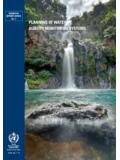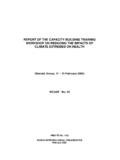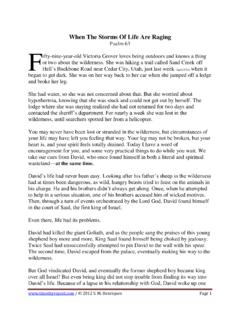Transcription of Climatology and Monitoring of Dust and Sand Storms in the ...
1 Mansour AlmazrouiCenter of Excellence for Climate Change Research (CECCR)King Abdulaziz University, Jeddah, Saudi ArabiaE-mail: and Monitoring of dust and Sand Storms in the Arabian PeninsulaThe dust and Sand stormsA dust storm or sandstorm is a severe weather condition characterized by strong winds and dust -filled air over an extensive area. A dust storm is distinguished from a sandstorm on the basis of particle size. dust Storms are made up of a multitude of very fine particles while Sandstorms have larger particle sizes that range from .08mm to fine dust particles may be elevated as high as 3kmor more while the sand particles are confined to the lowest , rarely rise more than 15mabove the storm The dust Storms problemsThis phenomenon appears as: A strong turbulent winds Blowing over desert surfaces Frequently lift large quantities of fine dust into the air Visibility can be reduced to a few meters Producing deep gloom or even total darkness dust storm is the generic term for a serious environmental phenomenon in the Arab countries.
2 dust storm causes at least the following: It causes considerable hardship It causes loss of income It disrupts communications It affects peoples health It leads to death of people (in extreme cases) It destroy livestock and crops over the affected areasThe dust Storms FormationEnvironmental Factors: Main environmental factors that affect the probability of occurrence, intensity, and height of dust Storms are: Wind speed Atmospheric stability Source region surface characteristics Additional factors pertaining to the efficiency of a dust source region are: Surface heating Soil moisture Soil type and Surface vegetationIn addition, strong surface heating can provide the necessary buoyancy to elevate dust to great storm frequency and intensity vary largely from one location and event to another. The dust Storms Impacts Smaller dust particles stay in the atmosphere much longer time than the large particles and may be transported thousands of kilometers away.
3 This tiny particle can remain airborne for 30 days if it reached a height of 1km and no other vertical accelerations occur. A dust particles of radius m will spend an average of 14 days in the atmosphere while particles of m remain elevated for an average of days. dust from severe dust Storms may create low visibilities hundreds of kilometers from their point of origin. MeteosatMeteosat--8 (MSG8 (MSG--1) Spectral composite1) Spectral compositeDust storm in Riyadh 11 march 2010 dust storm in Riyadh 11 march 2010 Example of dust Storms impactsDust Storms Global distributionDust-prone Regions from Land Cover Types: Identifying dust -prone regions based on land cover characteristics can be refined by incorporating satellite data. Source Regions from TOMS Aerosol Index: The Total Ozone Mapping Spectrometer (TOMS) Aerosol Index provides a near real-time measurement of aerosols in the Storms Regional (Middle East / West Asia)Soil Types in the Middle EastIn Middle East/ West Asia regions, some areas are much more prone to dust Storms than others due to differing soils and climate.
4 Even in bare desert, the sandy areas, such as those found on the Arabian Peninsula, generally do not generate dust Storms . Areas with silt- and clay-rich soils, most common in Iran and Iraq, which are responsible for most dust this region, these fine-grained soils are found in areas of dry lake beds and river flood plain GapSeasonal and annual rate of dust Storms In some seasons and for about 30% of the time, on average, parts of the Middle East, especially Saudi Arabia, are affected by dust most vertically extensive dust Storms are more likely to occur predominately in the spring and fall when the air masses are typically conditionally Storms are frequent over all other eastern Mediterranean countries during hot afternoons and in interior desert regions from March through of the Arabian Peninsula dust stormsOmega at different atmospheric levels on 13 May 2005 Monitoring of dust StormsObservational StationsAERONET data in dust Storms studyThe AERONET (AErosol RObotic NETwork)
5 Program is a federation of ground-based remote sensing aerosol networks collaborated on by national agencies, institutes, universities, individual scientists, and program provides a long-term, continuous and readily accessible public domain database of aerosol optical depth, microphysical and radiative properties for aerosol research and characterization, validation of satellite retrievals, and synergism with other is available at 3 different quality levels: Level (Unscreened, Raw data) Level (Cloud Screened) Level (Cloud Screened, quality assured)Some of the most interesting products include:Aerosol Optical Depth (AOD)at wavelengths (1020, 870, 675,500, 440, 380, 340) in Parameter ( )at the wavelength ranges (440-870), (380-500), (440-675), (500-870) and (340-440) in Size Distribution, just few to mention in wide output product sites distribution over Middle East Arabian Peninsula has 28 sites: Saudi Arabia (3) UAE (21) Bahrain (1) Kuwait (2) Muscat (1) Iraq, Syria, Jordan (0) Egypt (3) Iran (1)AERONET site Hada Al ShamJust 3 locations in Saudi Arabia.
6 Only Solar Village (Riyadh) has long record. Others Two just station in Jordan, Syria, Lebanon, to have more stations in the AOD (500 nm) at Solar VillageSeasonal March-April-May (MAM) variation of AOD at 500 nm over the Solar Village in is composed of the months when we have most of the dust loading activity in the region. So we see from figure that the AOD has a positive trend. Meaning that the dust activity has been increased significantly during the spring of dust StormsSatelliteSatellite data in dust Storms monitoringType of MSGS ensor NameBandSpectralResolution( m)SpatialResolution(km)TemporalResolutio n(Times)RadiometricResolution(Bit)Meteos at-8 SEVIRIVIS to minutes10 VIS to to to to to to to to to to to of Meteosat Second Generation (MSG) Satellites Spectral Channel ( Channel 9) from Meteosat Second Generation (MSG) satellite is used to monitor the temporal and spatial extent of the event.
7 The event was generated over Iraq at 02:00 UTC (12 May) with the geographic location of N and E near the meteorological station of Rafha (Saudi Arabia). With the passage of time, the event steadily increased to expand and started to move towards south and south east directions from its origin. While moving in these directions, it hits the met stations of Rafha, Gassim, Qaisumah, Hafer Al Baten, Riyadh and Kuwait. The event reached to its peak extent at 13:15 UTC (16:15 SST) and after that the expansion and intensity of the event was gradually started to decrease and the event was ended completely on 14 May 2013 at around 03:00 UTC over the Arabian Event in Saudi Arabia on 12-14 May 2013 dust Event in Saudi Arabia on 12 May 2013 Near Rafha Airport (north Saudi Arabia)from a plane that was just about to land (elevation 1000m) dust Event 13 May 2013 Tokar Gap is shown here.
8 This is one of the dust source areas from which dust Storms traversed to the Arabian Peninsula, particularly towards Saudi Gap dust Event 22 May 2013Un-Processed Data( dust event is not much clear) dust Event 22 May 2013 Data( dust event is very clear) RGB CompositeR = - = - = Data can be seen in the following link: Monitoring of dust StormsWeather and Climate ModelsClimate ModelsRegional Climate Models (RCMs)Global Climate Models (GCMs)RegCMWRF/MM5 PRECISKAU-CGCMSPEEDYCMIP3 Currently CECCR workingGCMs RCMsWave Watch IIIF orecasting of dust stormsA Regional Climate Model (RCM) is used to simulate the wet season dust source averaged for 1998-2009. Sub-regions A and B are used later for temperature and rainfall SeaRed SeaArabian GulfIncrease dust concentration reduced rainfallForecasting of dust stormsThe Weather Researched Forecast (WRF) model which is a mesoscale model with nested domain downscale up to 1 km.
9 It used to forecast all weather feature with spatial scale few km (convection scale) to hundred km ( synoptic wave scale).Mesoscale ModelRiyadh: 11 March 2009 Forecasting of dust stormsMesoscale Model18Z 25 MAR 201112Z 26 MAR 201106Z 27 MAR 201100Z 28 MAR 2011 Forecasting dust Storms : TODAY & TOMORROWTODAY: 28 May 2013 TuesdayTOMORROW: 29 May 2013 WednesdayCECCR simulated dust storm using Weather Researched Forecast (WRF) for Today & Tomorrow. Forecast is performed based on 12 UTC boundary conditions of the previous Remarks Preliminary results on dust Storms are discussed. Detail study ( filter dust from cloud) based on satellite data are required. WRF mesoscale model is useful for now-a-cast to short-term forecast of dust Storms . RCM is useful in long-term forecast of possible dust Storms . CECCR is working with National/ Regional/ International Institutes involved in Climate Change Research and will continue in expanding dust Storms You All














![[This page intentionally left blank.]](/cache/preview/e/d/9/f/6/3/a/6/thumb-ed9f63a64caa74df4ab07d8695ff2ea7.jpg)
